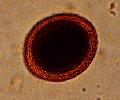Difference between revisions of "Ascaridoidea"
Jump to navigation
Jump to search
| Line 34: | Line 34: | ||
the placenta or enter the mammary glands (examples of vertical transmission); while some species will utilise | the placenta or enter the mammary glands (examples of vertical transmission); while some species will utilise | ||
paratenic or intermediate hosts. | paratenic or intermediate hosts. | ||
| − | |||
| − | |||
| − | |||
| − | |||
| − | |||
| − | |||
[[Ascaridida]] | [[Ascaridida]] | ||
Revision as of 12:43, 9 January 2009
| This article is still under construction. |
|
|
General Appearance
- Non-bursate
- Big fleshy worms; typically 5-40cm long (depending on age, sex and species)
- Three lips around the mouth
- A single-bulbed pharynx
General Life-Cycle
- Adult females in small intestine lay eggs
- Eggs have a thick protective shell
- Some also have a sticky outer albuminoid coat
- Eggs passed in faeces
- L1 → infective L2 inside the egg
- Infection is by ingestion of the embryonated egg (egg in which a larva has formed)
- Eggs can remain viable in humid environment for up to 5 years
- After hatching in the intestine, the larvae of most species (but not all) undergo hepato-tracheal migration:
- egg hatches in intestine → larva penetrates intestinal mucosa → hepatic portal blood → liver → venous blood → heart → lung capillaries → alveoli → ascends trachea → swallowed → small intestine (where the adults develop)
NOTE: there are important variations on this theme; for example, the migratory larvae of some species can cross the placenta or enter the mammary glands (examples of vertical transmission); while some species will utilise paratenic or intermediate hosts.
Occlusion of pancreatic ducts sometimes happens Pancreas - parasitic
In Peritoneal Cavity Parasitic - Pathology
- Parascaris equorum in rhinitis and lungs
- Ascarid larvae in myositis



